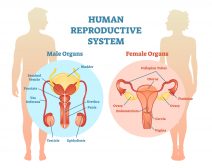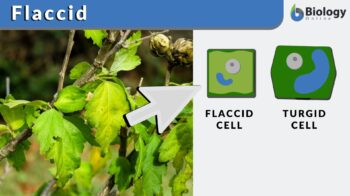
Flaccid
adj., [ˈflæsɪd]
Definition: weak; soft; lax; lacking vigor; in botany, a cell lacking turgidity
Table of Contents
Flaccid Definition Biology – What is Flaccid?
In botany, the term flaccid refers to a cell that lacks turgidity, i.e. it is not swollen and plump, but loose or floppy and the cell has become drawn in and pulled away from the cell wall (Figure 1).
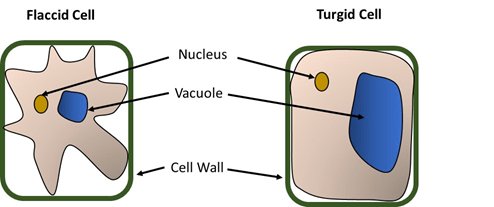
The flaccid medical definition refers to a limp or weak muscular tone. It is also described as hypotonia. Flaccid muscles are caused by various neurological and non-neurological conditions.
Flaccid Cell and Tonicity
What does flaccid mean? To understand how a plant cell becomes either flaccid or turgid, we must first understand the concepts of osmosis and tonicity.
Osmosis
Osmosis occurs in many plant and animal cells with a semipermeable membrane. It is the process by which solvents (e.g. water) diffuse across a semipermeable membrane. This process is powered by the difference in the concentration of solutes (e.g. salts) on each side of the semipermeable membrane. Solvents are the materials that do the dissolving and solutes are the materials that can be dissolved. In a plant cell, for example, water will move from a low solute concentration to a higher solute concentration, through the cell membrane. This process continues until both sides of the semipermeable membrane have the same amount of water molecules.
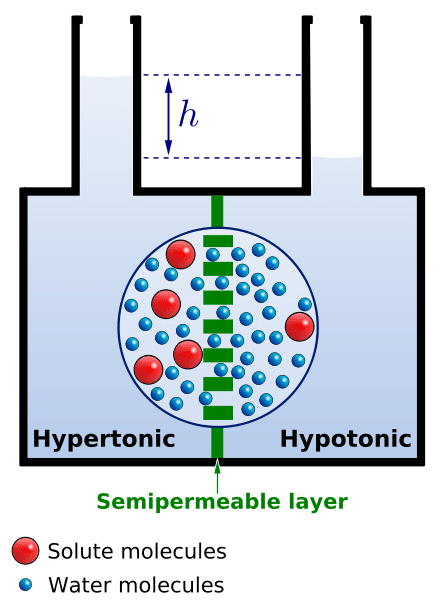
Tonicity and Osmolarity
Tonicity refers to the concentration of solutes outside a cell compared to the concentration of solutes inside the cell. The tonicity determines which direction, and how much water moves across the semipermeable membrane via osmosis. Solutes that cannot pass across the semipermeable membrane contribute to tonicity.
Osmolarity is defined as the concentration of a solution as measured in 1 liter of water. If two solutions have different osmolarities, the solution with the highest osmolarity is described as hyperosmotic, and the solution with the lower osmolarity is described as hypoosmotic. Two solutions that have the same osmolarity are termed isosmotic.
Dissolved solutes such as glucose or sodium add to osmolarity (osmotic pressure) because they are partly limited to the extracellular fluid side of the semipermeable membrane. Water will always move from a smaller osmolarity to a greater osmolarity until equilibrium is achieved on both sides of the membrane.
Tonicity differs from osmolarity because it involves not only the concentration of the solutes on each side of the cell membrane but also the permeability of the cell membrane to the solutes.
As with osmolarity, solutions can be defined as hypertonic, hypotonic, and isotonic. In a hypertonic solution, water is forced out of a cell because the extracellular fluid has a lower concentration of water compared to the inside of the cell. In a hypotonic solution, the opposite is true, and water is forced into the cell due to the higher concentration of water outside the cell compared to the inside. In an isotonic solution, the tonicity of the liquid outside the cell is equal to that inside the cell. Water moves in and out of the cell membrane at equal levels (Figure 3).
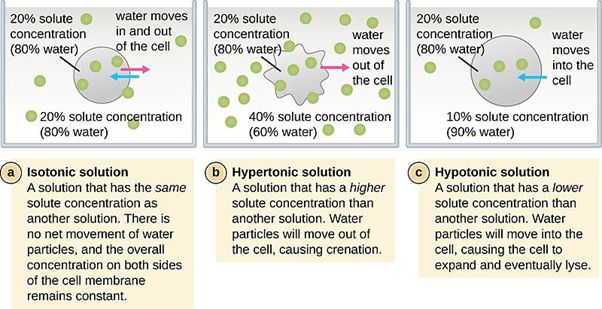
Flaccid in Botany
How does a cell become flaccid? The flaccidity of a plant cell is determined by the tonicity of the extracellular fluid. When a plant cell is placed in a hypertonic solution, more water leaves than enter the cell and the result is a flaccid plant cell. This process is known as plasmolysis and the cell is said to have become plasmolyzed.
In contrast, a cell placed in a hypotonic solution will swell and become turgid as more water can move into the cell rather than out of the cell.
What happens to a cell in an isotonic solution? [c]Cells placed in an isotonic solution would have an equal amount of flow into and out of the cell and its size would remain stable.
To maintain their growth and survival, plant cells need to be turgid. Plants that have become flaccid (or wilting), will struggle to survive. Plant cell walls consist of polysaccharides made of cellulose, hemicellulose, pectins, and other proteins that aid in structural ways giving them strength.
The solute difference between the inside of the cell (in the cytoplasm) and the outside of the cell creates hydrostatic pressure. This is also known as turgor pressure. It is described as such because it puts the cell walls under tension, which allows it to keep its shape and function normally. The rigidity of the plant cell wall prevents the lysis of the cell during expansion.
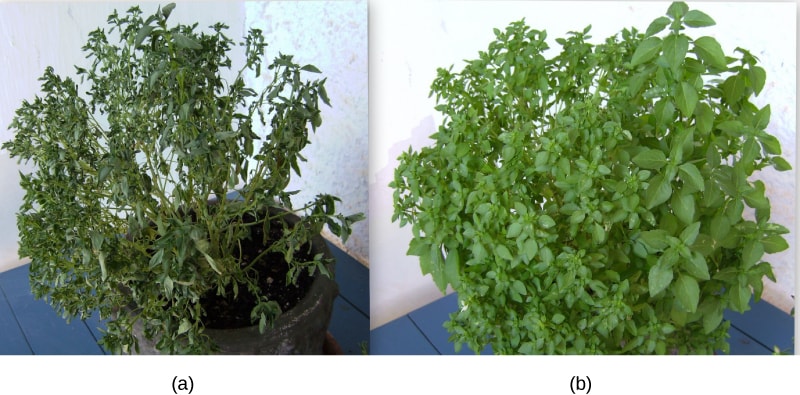
When plants begin to wilt, the large vacuole in the center of the cell begins to shrink. The vacuole in the plant functions not only as a storage organelle but also helps to maintain turgor pressure. The vacuole in plants can take up most of the room in the cell (Figure 5). The cytoplasm then decreases and the pressure on the membrane and the cell wall is lowered. The cell has now become flaccid.
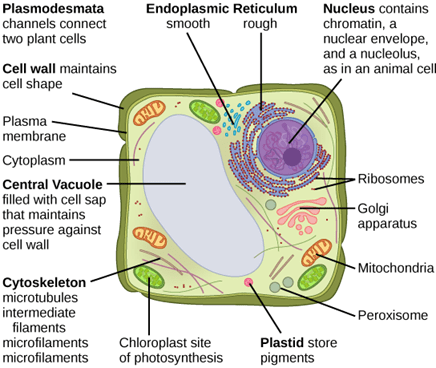
Wilting in plants can be caused by different environmental factors:
Drought
During droughts, the level of water in the soil is low, therefore the water cannot be taken up by the plant and it begins to wilt.
High salinity
In soil, which is high in salt, water will naturally go from the plant into the soil via osmosis due to the high solute concentration of the soil.
Low temperatures
During low temperatures, the water can freeze, preventing water from being taken into the plant.
Bacterial or fungal infections
Bacterial or fungal infections can prevent the vascular system of the plant from functioning correctly due to blockages or diseased tissue.
Permanent wilting will lead to the death of the plant because it can no longer transpire or grow. Stomata (pores) on the surface of the leaves in plants are surrounded by guard cells, which when turgid allow the stomata to remain open (Figure 6). Wilting results in the closure of the stomata which prevents the natural flow of carbon dioxide via diffusion into the plant, which inhibits the amount of photosynthesis that can take place. Without photosynthesis, the plant cannot make food for its survival.

Flaccid in Medicine
Flaccid paralysis in medicine can be caused by a range of disorders that affect the nervous system or the muscles. Acute flaccid paralysis (AFP) describes the manifestation of a broad range of clinical diseases that cause paralysis. Examples of such diseases include Polio, Guillain-Barre syndrome, Botulism, and Acute flaccid myelitis.
Polio
Polio is an example of a disease that may cause acute flaccid paralysis. Initial symptoms of polio infection include fever, sore throat, tiredness, and headache. In severe cases, it can cause meningitis and paralysis or muscle weakness. Thankfully, the huge worldwide vaccine effort by the World Health Organisation initiated in 1988 has massively reduced the number of cases of polio found today.
Guillain-Barre Syndrome
Guillain-Barre syndrome (GBS) is another condition that affects the nervous system resulting in acute flaccid paralysis. GBS is an autoimmune disease. Studies have shown that 60% of individuals with GBS have autoantibodies towards gangliosides which are found in the plasma membrane of the central and peripheral nervous system. Therefore, antibodies towards these gangliosides can result in motor difficulties. GBS is often diagnosed after the result of an infection such as flu or food poisoning. There are molecular mimicries between the gangliosides and the molecules on the surface of the infectious agent that caused the initial flu or food poisoning. This suggests that the initial infection is the trigger for the immune dysfunction. Symptoms of GBS range between being mild to severe with significant paralysis. Currently, there is no cure but the most effective treatment to date is intravenous immunoglobulin from healthy donors that block the damaging antibodies.
Botulism
Botulism is an uncommon disease that affects the nervous system. It is caused by the toxins produced by bacteria from the genus Clostridium (e.g. Clostridium botulinum). Botulism can affect both animals and humans but always gives the same symptoms of flaccid paralysis of all voluntary muscles which left untreated can lead to death. Treatment is via the administration of antitoxins. The neurotoxin in clostridium species disrupts neurotransmission which leads to the inability to move muscles. Since their discovery, these toxins have been used in a variety of medical conditions. It is used to treat eye disorders, muscle stiffness, and muscle spasms along with cosmetic procedures such as Botox, which involves placing the toxin in areas causing muscle flaccidity and resulting in the lessening of wrinkles.
Acute Flaccid Myelitis
It is thought that Acute Flaccid Myelitis (AFM) is caused by an infection with an enterovirus. Enterovirus infections are very common in young children and most recover well. However, some develop acute flaccid myelitis which is a serious condition and can be life-threatening because it can affect breathing due to severe muscle weakness. Currently, there is no optimal treatment for AFM, intravenous immunoglobulin can be given to boost the immune system. Steroids and plasma exchange have also been used in some individuals and have been effective.
Try to answer the quiz below to check what you have learned so far about flaccid.
References
- Aureli, P. (2017) Botulism. International Encyclopedia of Public Health (Second Edition) Academic Press. 254-262. https://doi.org/10.1016/B978-0-12-803678-5.00038-2
- Ayukekbong, J.A. Bergström, T. (2014) Polio will go, acute flaccid paralysis will stay. The Lancet. 383 (9936) 2209-2210. https://doi.org/10.1016/S0140-6736(14)61080-1
- Beauzamy, L., Derr, J., Boudaoud, A. (2015). Quantifying Hydrostatic Pressure in Plant Cells by Using Indentation with an Atomic Force Microscope. Biophysical Journal. 108 (10) 2448-2456. https://doi.org/10.1016/j.bpj.2015.03.035
- Feher, J. (2017). Osmosis and Osmotic Pressure. Quantitative Human Physiology (Second Edition). 2.7 182-198. https://doi.org/10.1016/B978-0-12-800883-6.00017-3
- Himme, B. Tonicity. Pathwayz. https://www.pathwayz.org/Tree/Plain/TONICITY#:~:text=process%20called%20plasmolysis-,An%20isotonic%20solution%20does%20not%20result%20in%20any%20net%20movement,soft%2C%20drooping%20or%20inelastic).&text=The%20cell%20membrane%20starts%20to,turgid%20(swollen%20and%20firm).
- Hopkins, S.E., Desai, J., Benson, L. (2021). Acute Flaccid Myelitis: A Call for Vigilance and an Update on Management. Pediatric Neurology. 114 (26-28). https://doi.org/10.1016/j.pediatrneurol.2020.09.003
- Sanders, L.R. (2009) Water Metabolism. Endocrine Secrets (Fifth Edition). 24, 205-226. https://doi.org/10.1016/B978-0-323-05885-8.00024-6
- Uchibori A, Chiba A. (2015) Autoantibodies in Guillain-Barré Syndrome. Brain Nerve. 67(11):1347-57. 10.11477/mf.1416200305
- Wayne, R. (2010). Chapter 7, The Vacuole. Plant Cell Biology. Academic Press. 7, 101-118. https://doi.org/10.1016/B978-0-12-374233-9.00007-6
- What is Polio. (2019). Centers for Disease Control and Prevention. https://www.cdc.gov/polio/what-is-polio/index.htm
©BiologyOnline.com. Content provided and moderated by BiologyOnline Editors.

